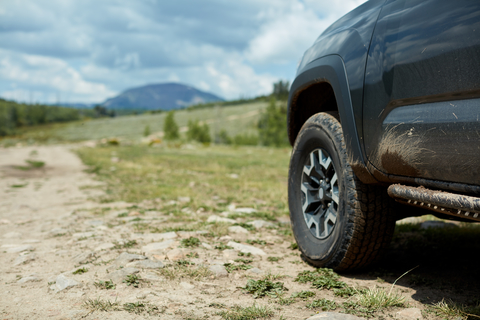June 12, 2018 | JAX Tyres
 Is one spare wheel enough when heading to the Outback?
Is one spare wheel enough when heading to the Outback?
Gravel roads and other rough surfaces are a constant hazard to 4WD tyres when you’re driving off the beaten path.
You wouldn’t set off on an epic Outback road trip without carrying a spare wheel and tyre, but what if two of your tyres get punctured on the same stretch? That’s not as unlikely as you might think, and could leave you stranded in the middle of nowhere.
Is carrying a second spare worth it?
It’s always better to be safe than sorry when you’re heading out into the unknown, but it depends on the distance you’re going.
If you’re driving a relatively short and safe route, a single spare will usually be all you need, especially if you’ve got a tyre repair kit and you know how to use it. You could also get by carrying a second spare tyre with no rim.
If you’re really heading off the map though, putting your 4WD through its paces and driving over sharp stones, the minor inconvenience of carrying a second spare can be invaluable.
Pre-inflated or flat?
A ready-inflated tyre, correctly fitted to a steel or alloy rim, is ideal for emergency replacement if you get a puncture. However, weighing in at roughly 40kg and taking up considerable space, a ready-inflated spare isn’t a convenient option for everyone.
If you’re trying to save space and weight in your 4×4, you might prefer to carry a bare wheel and tyre case. The tyre can be inflated if you end up needing it, as long as you have the right equipment and know-how. This can take up to a few hours.
It’s essential that you inflate them to the right pressure. As this changes based on the surface you’re driving on, a pressure gauge and inflation machine that uses the vehicle’s engine for power are other indispensable bits of kit for your road trip.
What’s the best place to carry your spares?
If you do choose to carry a ready-inflated tyre and rim, what’s the best place to store it?
Roof rack
Most experienced road trippers agree that it’s worth investing in a ratchet and strapping your spares securely to the roof rack. Out of sight doesn’t mean out of mind though, as you’ll need to adjust for the high centre of gravity when steering, climbing and descending. You’ll also need to take care when offloading the heavy wheels, preventing damage as well as injury.
Inside the vehicle
If you have the space, there’s no better place to keep your wheels and tyres safe from the elements than in your cargo space, ideally with convenient back door access. In reality though, not all of us have the luxury of space when heading off on a long trip.
Under the rear
4WD manufacturers used to prefer the bonnet for housing the spare wheel, but these days they’re more likely to be seen at the rear. If your main spare already takes pride of place here, a second can usually fit underneath, next to the rear axle. While this low centre of gravity can be handy, the wheel and tyre are at greater risk of damage in this position and can be harder to retrieve when needed.
Wherever you keep your spares, don’t set off without a good working knowledge of how to remove and replace a wheel and the tools you need for the job.
Read more 4WD driving tips to make sure you don’t overlook anything on your next big trip.

